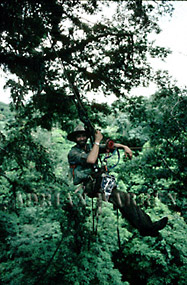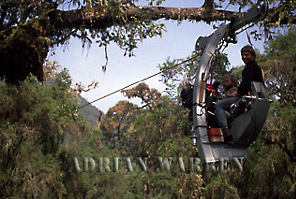Aerial track ways. Back in the early 1980s, Neil Rettig and I experimented with ways to move a camera horizontally through the tropical rain forest canopy. He already had a lot of experience in climbing up to the rain forest canopy, and together we had worked out some techniques for obtaining vertical tracking shots, using pulleys, with some very smooth and pleasing results. Moving the camera horizontally though proved to be a much bigger problem. To start with, we employed climbing rope. The problem was that it stretches alarmingly (even non-stretch caving rope), so that when one cast oneself off a tree platform, suspended by a pulley, the initial part of the ride was almost vertical before shooting off sideways. Needless to say, it was difficult to hold a camera steady during this experience. Finally one came to a halt halfway across the span and it was necessary to laboriously haul oneself back using jumars. The other thing about this was that it was not very safe. While climbing rope is very strong and is perfectly adequate when a person is suspended vertically, as soon as it is stretched horizontally to form a span, its breaking strain is reduced alarmingly.

(Neil Rettig on horizontal rope in Costa Rica)
So we started using steel cable, which was much more successful, using hand winches to tighten it between two stout trees. We rigged the cable at an incline of about four degrees, to give a little gravitational speed, but not too much when one cast off from the platform on a seat suspended by pulleys. In those early experimental days we did not use brakes, only outstretched feet to lessen the impact on the tree at the lower end. Neil became something of an expert at this technique, producing some beautiful shots filmed at 75 fps.
The real challenge came when we were making an IMAX film on Mountain Gorillas. With a huge camera weighing in at 120 lbs we obviously had to design a much stronger system than we had employed to date, and this time with brakes designed from bicycle parts. The result was a cable car built from carbon fibre, able to carry two persons plus the camera.

(IMAX aerial dolly system)
